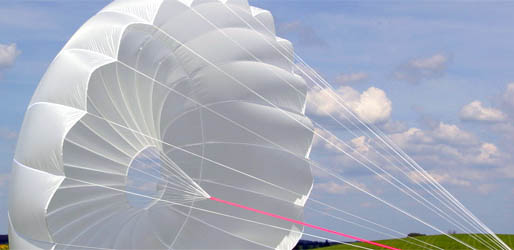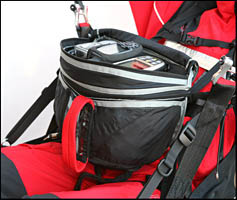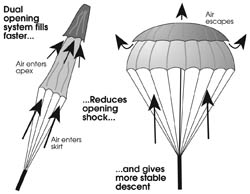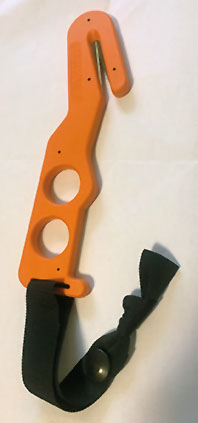
In stock is a range of emergency parachutes from Charly and FreeFlight. All come with a packing manual and instructions and advice for deployment. If you send your harness, the reserve can be installed for you.
Emergency parachute basics
Many accidents happen close to the ground, so a fast, reliable opening is most important. If you are falling, every second, every part of a second puts you closer to impact, so you need to get that chute inflated asap!! Some factors that can be critical in this situation are;
Your Technique; you must know and practice what to do, so that precious seconds are not wasted; Look, Grab, Pull, Throw. Also landing technique; For paragliders a 'parachute landing fall' (PLF); feet together, knees bent, chin down, elbows in and roll to the side to disperse landing impact. For hang gliders, stand inside the A frame to let the glider frame take the impact, then be ready to cut the parachute bridle if its windy to avoid being dragged.

Your Gear; Your parachute handle should ideally be where you can see it and reach it with either hand (in case one is disabled). This is not the case with many hang glider and paraglider harnesses. You could choose a harness that has a better mounted parachute, Ideal is right in front where you can see it. Most paraglider harnesses can be fitted with a front reserve which has the added benefits of having less drag and a handy instrument cockpit. There are few hang glider harnesses with a front parachute. Regardless, you should practice grabbing that handle. You might be upside down or spinning in the real life situation so that could take several tries unless well practiced.
Choice of parachute can make a difference. Smaller parachutes open quicker, but you also fall further. Never mind the speed of deployment, it's the distance you fall before they work that's most important. Go by the manufacturers recommendation for size; too small and injury on landing is more likely. Too large and instability may even deflate the canopy.
The Pulled Down Apex (PDA) design canopy has become the standard for hang glider and paraglider parachutes, because they open fast at the lower speeds that we are most likely to be using them. Another benefit is they can be smaller in size. They are not designed for higher speed free fall deployment, though some like the FreeFlight canopies are tested to similar loads.

Regular repacking is essential for most reserves to work correctly. The dual canopy, pulled down apex system opens fast and reliably. I like the Revolution double cap reserves which due to effectively having 16 drogues, are less dependent on being recently packed. Most parachutes are packed with a centre channel for the airflow during the opening, but unless repacked regularly, this channel is likely to be filled as the slippery fabric moves around during normal handling. Standard reserves take much longer to open if not recently repacked, but double cap reserves open quickly regardless. This is not to say they shouldn't be repacked regularly as other things like rubber bands need regular checking and replacement. But for those pilots who may repack only once a year or so, this can be an advantage that saves them.
There are new models like the DiamondCross which not only are lighter and smaller, but perform better and are designed to only require yearly repacks. The paraglider version has optional steering which can help land you where you want.
I once had to deploy after losing control of a competition paraglider wing in a strong thermal. I thought I was done for after I fumbled the deployment with borrowed oversized gloves on and saw the trees coming up fast! Witnesses said I was below 50ft when the canopy opened and I was on the ground a split second later. Another second or part of a second and I would have been seriously injured. This brought home to me that even a tiny delay could have a terrible consequence and that it's worth doing everything possible to improve your chances.
Parachutes suffer from age. Rubber bands break down and stick to the fabric, insects and rodents make holes, mildew and mould growth are all things that a repack/inspection can reveal. Also fabric will lose porosity over time and chemical degradation can occur, like on paraglider wings. Manufacturers usually advise replacement after 10 or 15 years. In my opinion, if it's not a PDA, then it's probably 20 years old or more and it's more use cut up into windsocks. Later designs are faster opening, lighter and less bulky and certified so you know they will work. Though I recommend paraglider pilots do an SIV course and deployment over water I would not recommend keeping any parachute that had been used this way. There is potential for line stretch or shrinkage, fabric stretching and changes in the the fabric coating and porosity. Perhaps this is a good place for older reserve canopies to go before they are retired.
I have seen many emergency parachutes that could not have been deployed because they were installed incorrectly. Though any parachute of suitable size can be installed in most harnesses, many harnesses require a handle that it made to fit that harness or deployment could be compromised. This is especially so on many paraglider harnesses and later hang gliding harnesses. There have been many manufacturing defects reported for parachute handles.
More information and specifications;
Charly parachutes, Paragliding info
Charly parachutes, Hang gliding info
Free Flight parachutes info
Call and I can advise on which parachute would suit you best.
Optional extras;
Hook knife; This can be a lifesaver, Cut free any lines or webbing that may be restricting your body or equipment during a deployment, or in a water landing. For hang gliders, there have been plenty of pilots who have landed safely, to then dragged into other dangers like water or power lines. A hang glider parachute is on a long bridle so in even light winds the chute will stay open, dragging pilot and glider until it catches on something. There is no way to collapse the chute and the hook knife simply cuts the bridle which is cheap to replace. This model has double replaceable blades and comes with a pouch.

 Hang glider pilots are recommended a swivel which is installed at the parachute end of the bridle. This prevents a spinning hang glider from closing up the parachute. Videos of this happening can be found YouTube. Swivels are included on FreeFlight HG reserves and are optional on Charly HG reserves.
Hang glider pilots are recommended a swivel which is installed at the parachute end of the bridle. This prevents a spinning hang glider from closing up the parachute. Videos of this happening can be found YouTube. Swivels are included on FreeFlight HG reserves and are optional on Charly HG reserves.
Other equipment in stock, Front container, cockpit for PG
Bridle with UV cover for HG with or without swivel,
Connecting shackles (Maillon Rapides)